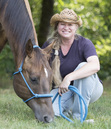The Shabti: A Debut Urban Fantasy
The Shabti, debut urban fantasy by Megaera C Lorenz
Author Interview + Book & Author Info + Author Pet Corner!Don’t miss any debut author interviews, click the link here for more.The Shabti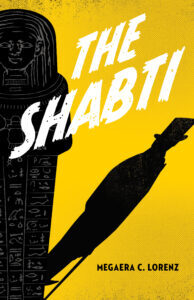 Can you flimflam a ghost?
Can you flimflam a ghost?
It’s 1934. Former medium Dashiel Quicke travels the country debunking spiritualism and false mediums while struggling to stay ahead of his ex-business partner and lover who wants him back at any cost. During a demonstration at a college campus, Dashiel meets Hermann Goschalk, an Egyptologist who’s convinced that he has a genuine haunted artifact on his hands.
Certain there is a rational explanation for whatever is going on with Hermann’s relics, Dashiel would rather skip town, but soon finds himself falling for Hermann. He agrees to take a look after all and learns that something is haunting Hermann’s office indeed.
Faced with a real ghost Dashiel is terrified, but when the haunting takes a dangerous turn, he must use the tools of the shady trade he left behind to communicate with this otherworldly spirit before his past closes in.
For readers who enjoy A Marvellous Light by Freya Marske, The House in the Cerulean Sea by TJ Klune, and Malice by Heather Walter
To purchase The Shabti, click on any of the following links: Amazon, Barnes & Noble, CamCat Books, Bookshop.org, Librio.fmInterview with Megaera C Lorenz, Author of The ShabtiThe Shabti is set in 1934. What drew you to that era and what did your research look like?I fell in love with the 1930s around the same time I fell in love with Egyptology, when I was 9 or 10 years old. It started when my parents rented a video of Betty Boop cartoons that included the trippy pre-Code masterpiece Minnie the Moocher, which features a very young Cab Calloway.
If you’ve never seen this cartoon, I urge you to look it up on YouTube. It’s wild. Young me was instantly hooked. My fascination with the cartoon—and with Cab Calloway—blossomed into a lifelong obsession with 1930s American popular music, cartoons, film, and history.
I especially adored the Universal monster movies of the 1930s growing up. I watched my favorite three—The Mummy, Bride of Frankenstein, and Dracula—countless times. I’ve always loved the idea of writing a story with the flavor of those films, set in that era. I wanted to create something with that same magical combination of glossy noir aesthetic, spooky thrills, romance, and camp/pulpiness.
My research, as far as the setting was concerned, involved a lot of work making sure the little period details were accurate. I pored over 1930s train schedules, hotel and restaurant menus, and even medical journals. I also combed through historical society and library archives for local details. I visited Hotel Baker and the Rainbow Room here in St. Charles several times to get a strong sense of place for the grand finale.
The Shabti centers on a former medium, Dashiel Quicke. Dashiel, now a nonbeliever, faces the supernatural. That’s a great twist! What drew you to writing about the paranormal?
I’ve always been intrigued by the uncanny. I think I first got really interested in Spiritualism and mediums when I read Spook by Mary Roach in my early 20s. For some reason, the phony mediums of the 19th and early 20th centuries fascinate and creep me out at least as much as the notion of real ghosts. I find the old spirit photographs and the pictures of mediums producing gauze ectoplasm and papier–mâché spirit faces to be incredibly eerie, even when they’re so obviously fake.
And of course, the supernatural and ancient Egypt are two great tastes that taste great together. The ancient Egyptians themselves had a long tradition of ghost stories, and they’ve been the subject of many modern tales of the paranormal. As I mentioned above, I grew up on movies like the original 1932 version of The Mummy, which of course had a major impact on the tone and themes of The Shabti.
I’d had the idea of writing a story about an Egyptologist haunted by a meddlesome ghost for ages, but it wasn’t until a few years ago that it really clicked for me that I could combine my interests in Egyptology and American Spiritualism to make something really fun and unique.
What else should readers know about Dashiel Quicke, the central character in The Shabti?
Dashiel was loosely inspired by a real person, M. Lamar Keene. Keene was a fraudulent medium—a very successful one, by his own account—who was mostly active in the 1960s. Eventually, he broke free of the business and worked to expose the shady tricks of the trade in the hopes that he could make amends and help prevent more people from being defrauded. His memoir/tell-all, The Psychic Mafia, was a vital source of information and inspiration to me when I was writing The Shabti.
Like Keene, Dashiel is a phony medium who eventually tires of the racket and decides to leave it behind. He’s dogged by guilt about his past, but he’s lived as a con artist for so long that he doesn’t really know how to do anything else. He’s deeply cynical about people in general and scornful of the notion that there’s any kernel of truth behind the tenets of Spiritualism.
But for all his cynicism and world-weariness, Dashiel has a lot of love to give, and there’s a core of goodness in him. When he finally finds someone he can trust, the bond that forms between them runs fierce and deep, and Dashiel is willing to do almost anything to protect him.
You are also an Egyptologist. Tell us about your interest and career in such a fascinating (and unusual!) subject:
The ancient Egypt bug bit me when I sat in on a World Civilization class at the University of Guam, where my parents were teaching at the time. I was about 9 years old. I was so passionate about becoming an Egyptologist that I enrolled at the University of Guam at age 13, determined to get into grad school as quickly as possible. After I’d exhausted all the relevant classes there, I transferred to Penn State to finish out my undergrad career under the tutelage of Egyptologist Donald Redford.
I went to grad school at the University of Chicago. During that time, I participated in fieldwork in Egypt and Sudan, worked in the ISAC museum at U. of C. as a curatorial assistant and educational consultant, and taught Egyptology classes at the graduate and undergraduate levels. I earned my PhD in Egyptology in 2017, with a focus on the history, language, and literature of the New Kingdom.
After that, I wandered off the path of academia. I still love ancient Egypt, but I feel most truly myself when I’m doing creative work. And I’m not the only Egyptologist to go down this route. The first woman to earn a PhD in Egyptology in the U.S.—another U. Chicago alum—went on to become beloved mystery author Elizabeth Peters. I’m proud to follow in her footsteps. One of my former U. of C. colleagues, Malayna Evans, also just debuted her first adult novel, Neferura, which is set in ancient Egypt during the reign of Hatshepsut.
Digital art is another interest of yours. What resonates for you with that art form?
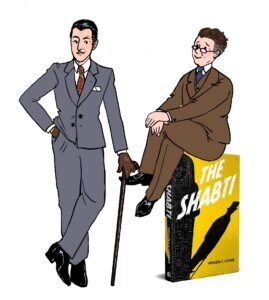
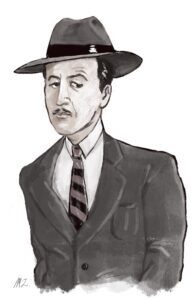 I love digital art because it’s so versatile. I can do things in Procreate on my iPad that I would struggle to ever pull off with traditional media. Bless whoever invented layers and clipping masks. But my digital art looks very traditional.
I love digital art because it’s so versatile. I can do things in Procreate on my iPad that I would struggle to ever pull off with traditional media. Bless whoever invented layers and clipping masks. But my digital art looks very traditional.
I mostly do pen-and-ink style drawings with flat colors or limited shading, but I’ve been experimenting with more painterly techniques.
These days, I draw lots of pictures of my characters. I did a series of portraits in a pseudo-1930s cartoon art style, but I’ve also attempted some more realistic renditions of them.
What are you working on now?
I’m writing a sequel/spin-off to The Shabti starring one of the secondary characters from the first book. She has a very different personality and voice from Dashiel’s, but I’m having so much fun with her. It’s another ghost story with a more traditional Gothic/haunted house vibe, but it has some interesting twists and turns that I’m excited about.
Words of Wisdom for Aspiring Writers:
Allow yourself to have fun. Write at least one book where you just cut loose and pour everything you love into it. I had such a fabulous time writing The Shabti, and the experience wouldn’t have been nearly as joyful if I hadn’t given myself permission to just be a big old earnest nerd about it all.
Author Pet Corner!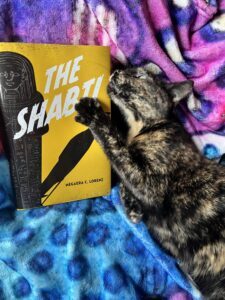 Nebi!
Nebi!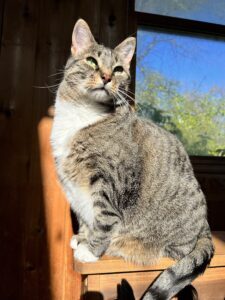 Sirius!
Sirius!I have two cats, Nebi and Sirius (don’t tell him he’s named after the Dog Star). Nebi is a delightfully weird little tortoiseshell who likes to be carried around on people’s shoulders.
Sirius is a big chonky goofball of a tabby, and he is the real-life model for Horatio, Prof. Hermann Goschalk’s cat in The Shabti.
 Max!
Max!I also have a Belgian Tervuren named Max. He’s a sweetheart, but he doesn’t know his own strength. He leaves a trail of chaos in his wake wherever he goes.
Megaera C Lorenz, Author of The Shabti
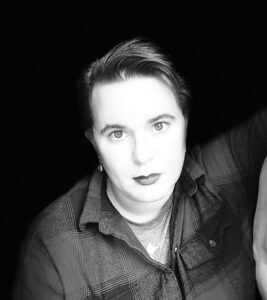 Megaera Lorenz is an Egyptologist and professional tech writer/editor who is fascinated with all things odd and uncanny.
Megaera Lorenz is an Egyptologist and professional tech writer/editor who is fascinated with all things odd and uncanny.
After earning her Ph.D. from the University of Chicago in 2017, she decided to pursue her lifelong interest in creative writing.
She loves to craft stories that tap into her interests and expertise and combine them in strange and surprising ways.
She has lived in the Chicagoland area for nearly 20 years. Currently, she resides in St. Charles, IL with her family, which includes two kids, two cats, and a hyperactive Belgian Tervuren.
To learn more about Megaera, click on any of the following links: Website, Goodreads , Instagram, Threads, Bluesky, X/Twitter, Tumblr & TikTok Elena Hartwell/Elena Taylor
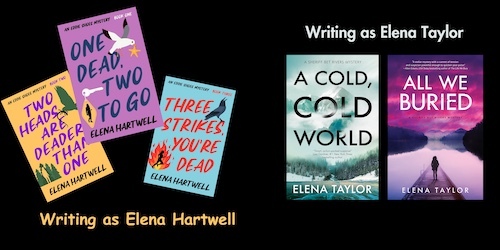
The post The Shabti: A Debut Urban Fantasy appeared first on The Mystery of Writing.

